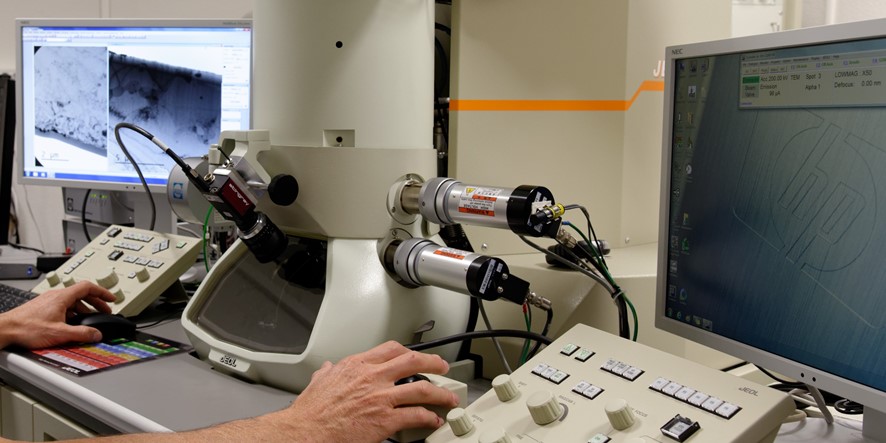Magnetic materials
Our group is involved in few collaborative projects related to the physics of magnetic materials. Our main interest is to characterise their magnetic structure, at different scales.
(Guillaume Beutier, Marc de Boissieu)
Atomic scale
Crystals can host complex magnetic structures and/or complex magnetic phase diagrams. Their determination is necessary for a good understanding of the fundamental physics at play and of their functional properties. One of the key magnetic interactions in modern magnetic materials is the asymmetric exchange interaction (also known as the Dzyaloshinskii-Moriya interaction, DMI). It was first introduced in the 1950’s to explain weak ferromagnetism, and it is now a fundamental ingredient to understand magnetoelectric materials, skyrmions, and other exotic magnetic structures. In a project lead in collaboration with Diamond Light Source and several other laboratories across Europe and Russia, we have determined the sign of the DMI in a series of isostructural crystals with different magnetic ions. We discovered a change of sign across the series and could relate it to the filling of the valence band. To carry this study, we developed an original interference technique using synchrotron radiation (See image below: two possible magnetic structures with the same net moment and opposite sign of DMI).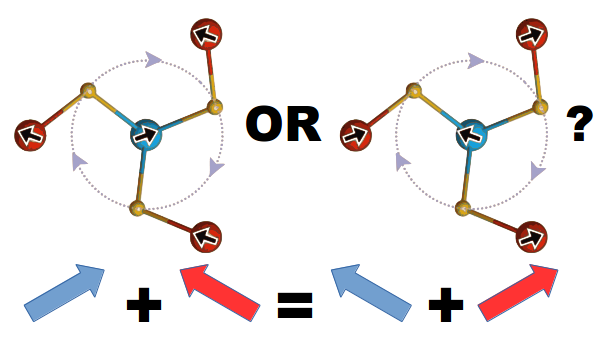
In another project in collaboration with Japanese and American labs, we study the magnetic order (or lack of) in quasicrystals and their periodic approximants. Interestingly, none of the Cd-R binary quasicrystals host long-range magnetic order, while some of the Cd6 periodic approximants do host long-range magnetic order at low temperature, despite very similar local atomic environments. We try to determine the magnetic structure in these materials in order to understand why it is not compatible with aperiodic order. As the matter of fact, no long-range magnetic order as ever been found in any quasicrystal, while theory cannot rule it out (See image below: layer-by-layer structure of the Tsai cluster, the building block of the Cd-R quasicrystals and their periodic approximants. Bottom: antiferromagnetic order between the Rare-Earth icosahedral shells in the Cd6R periodic approximants).
Microscopic scale
The magnetic structure shows also features at a larger scale: domains, domain walls, vortices, skyrmions, modulation… If the magnetic structure at the crystallographic scale governs the intrinsic properties of materials, their properties as functional devices is governed by their magnetic microstructure. It is thus of high interest to characterize it.
Our approach is to develop imaging techniques based on synchrotron radiation. Most of our past and current work is dedicated to ferromagnetic materials, as they are by far the most used in devices and can be easily studied using x-ray magnetic circular dichroism (XMCD). But we also plan to tackle the case of antiferromagnetic materials, which are nowadays intensely studied for spintronic applications. To image thin (< a few100 nm) ferromagnetic devices, we developed, in collaboration with the University of Exeter and Diamond Light Source, an holographic method providing magnetic images with spacial resolution down to 10 nm. The technique is compatible with various stimuli of the sample (electric current or field, magnetic field, cooling / warming) and time-resolved measurements with sub-ns resolution (synchrotron) or fs resolution (free-electron lasers). We are now developing a tomographic vectorial probe of magnetism, to be able to study more bulky samples (up to 10 micrometer thick), with applications foreseen for permanent magnets and magnetic sensors (See image below: Time-resolved imaging of Landau domains in a 2 micron-permalloy thin square under pulsed magnetic field. The trajectory of the vortex core is plotted on the right.)
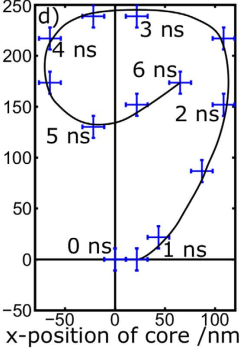
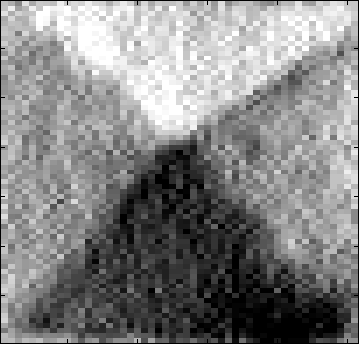
Selected publications:
(Guillaume Beutier, Marc de Boissieu)
Atomic scale
Crystals can host complex magnetic structures and/or complex magnetic phase diagrams. Their determination is necessary for a good understanding of the fundamental physics at play and of their functional properties. One of the key magnetic interactions in modern magnetic materials is the asymmetric exchange interaction (also known as the Dzyaloshinskii-Moriya interaction, DMI). It was first introduced in the 1950’s to explain weak ferromagnetism, and it is now a fundamental ingredient to understand magnetoelectric materials, skyrmions, and other exotic magnetic structures. In a project lead in collaboration with Diamond Light Source and several other laboratories across Europe and Russia, we have determined the sign of the DMI in a series of isostructural crystals with different magnetic ions. We discovered a change of sign across the series and could relate it to the filling of the valence band. To carry this study, we developed an original interference technique using synchrotron radiation (See image below: two possible magnetic structures with the same net moment and opposite sign of DMI).

In another project in collaboration with Japanese and American labs, we study the magnetic order (or lack of) in quasicrystals and their periodic approximants. Interestingly, none of the Cd-R binary quasicrystals host long-range magnetic order, while some of the Cd6 periodic approximants do host long-range magnetic order at low temperature, despite very similar local atomic environments. We try to determine the magnetic structure in these materials in order to understand why it is not compatible with aperiodic order. As the matter of fact, no long-range magnetic order as ever been found in any quasicrystal, while theory cannot rule it out (See image below: layer-by-layer structure of the Tsai cluster, the building block of the Cd-R quasicrystals and their periodic approximants. Bottom: antiferromagnetic order between the Rare-Earth icosahedral shells in the Cd6R periodic approximants).

Microscopic scale
The magnetic structure shows also features at a larger scale: domains, domain walls, vortices, skyrmions, modulation… If the magnetic structure at the crystallographic scale governs the intrinsic properties of materials, their properties as functional devices is governed by their magnetic microstructure. It is thus of high interest to characterize it.
Our approach is to develop imaging techniques based on synchrotron radiation. Most of our past and current work is dedicated to ferromagnetic materials, as they are by far the most used in devices and can be easily studied using x-ray magnetic circular dichroism (XMCD). But we also plan to tackle the case of antiferromagnetic materials, which are nowadays intensely studied for spintronic applications. To image thin (< a few100 nm) ferromagnetic devices, we developed, in collaboration with the University of Exeter and Diamond Light Source, an holographic method providing magnetic images with spacial resolution down to 10 nm. The technique is compatible with various stimuli of the sample (electric current or field, magnetic field, cooling / warming) and time-resolved measurements with sub-ns resolution (synchrotron) or fs resolution (free-electron lasers). We are now developing a tomographic vectorial probe of magnetism, to be able to study more bulky samples (up to 10 micrometer thick), with applications foreseen for permanent magnets and magnetic sensors (See image below: Time-resolved imaging of Landau domains in a 2 micron-permalloy thin square under pulsed magnetic field. The trajectory of the vortex core is plotted on the right.)


Selected publications:
- R. Takamura, Y. Muro, T. Hiroto, H. Yaguchi, Guillaume Beutier, T. Takabatake Structural and magnetic transitions in the crystalline Cd6Sm Phys. Rev. B, vol 85, pp. 014203 (2012);
- Guillaume Beutier, S. P. Collins, O. V. Dimitrova et al. Band Filling Control and Dzyaloshinskii-Moriya in Weakly Ferromagnetic Insulators Phys. Rev. Lett. vol 119, pp. 167201 (2017);
- P. Das, P.-F. Lory, R. Flint, T. Kong, T. Hiroto, S. L. Budko, P. C. Canfield, M. de Boissieu, A. Kressying and A. I, Goldman Crystal electric field excitations in the quasicrystal approximant TbCd6 studied by inelastic neutron scattering Phys. Rev. B, vol 95, pp. 054408 (2017);
- E. Burgos-Parra, N. Bukin, S. Sani, A. I. Figueroa, G. Beutier, M. Dupraz et al. Investigation of magnetic droplet solitons using x-ray holography with extended references Scientific Reports, vol 8, pp. 11533 (2018);
Metal-organic frameworks for gas separation and gas detection
We are interested in understanding the electronic structure of different families of MOFs in order perform a computational design of optimum materials for gas capture and separation (CO2, NO2, SO2, H2S ...) and sensors. Specifically, we study lanthanide-based MOFs, spin crossover (SCO) MOFs and photoresponsive MOFs. The idea behind our current research is to develop novel MOFs that can efficiently desorb gas molecules upon light irradiation, using azobenzene functionalized MOFs, or under T-induced spin transition for spin crossover MOFs (see image below: illustration of the CO2 adsorption/desorption mechansim using visible light in the PCN-123 azobenzene functionalized MOF).
(Roberta Poloni)
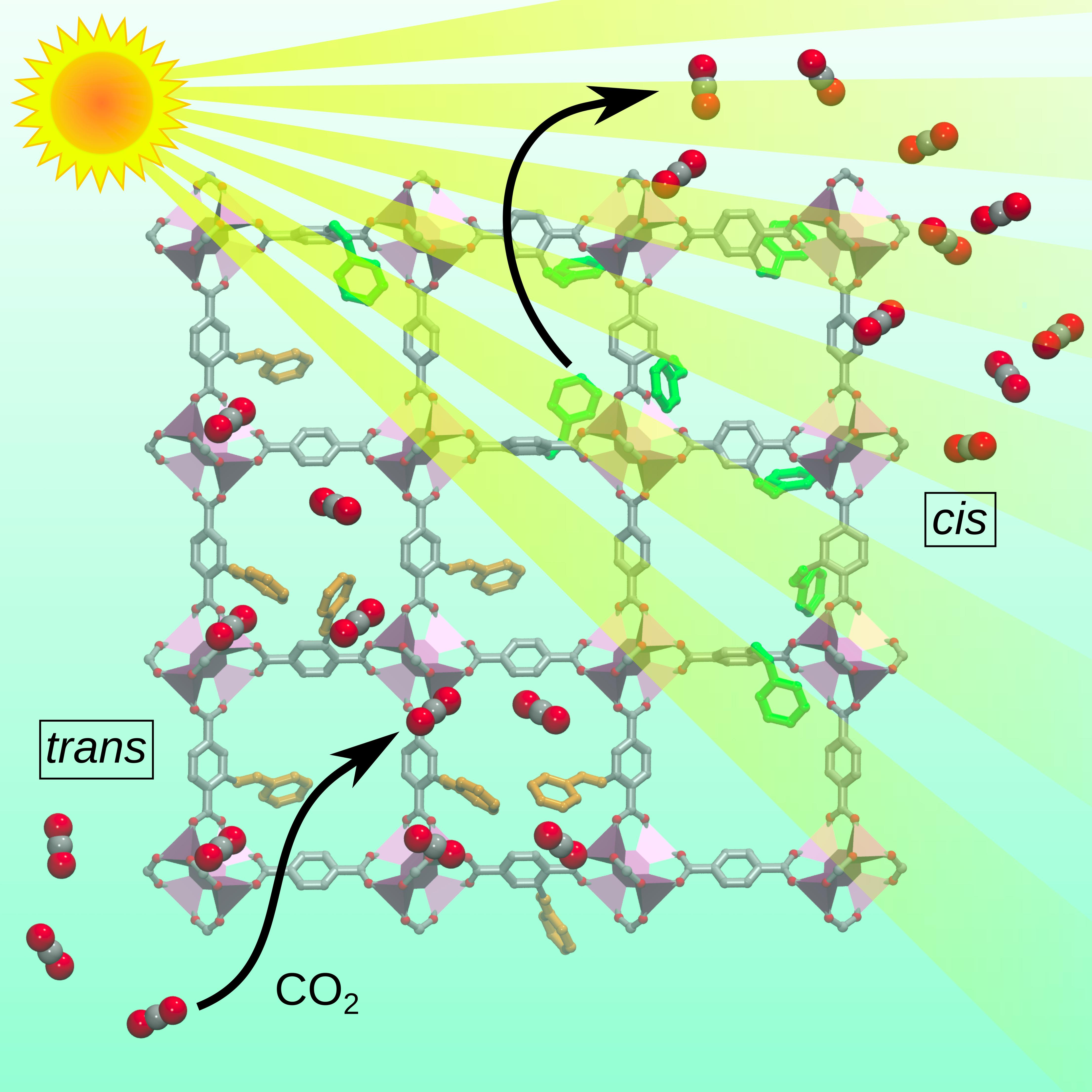
We use, tweak and combine different electronic structure methods in order to adopt the best computational methos for each case. The methods we use are DFT, TDDFT, many-body formalisms such as GW/BSE and multiconfigurational second-order perturbation CASPT2. Classical Monte Carlo simulations are performed in collaboration with Ohio State University. We take pleasure in collaborating with several other computationalists and experimental groups.
Image below: optical spectra of azobenzene and fluorinated azobenzene computed by using GW/BSE and adopting varying embedding schemes coupled with a orbital-tuning approach. An excellent agreement with experiment is found for the fully embedding scheme (see publications in JCTC below).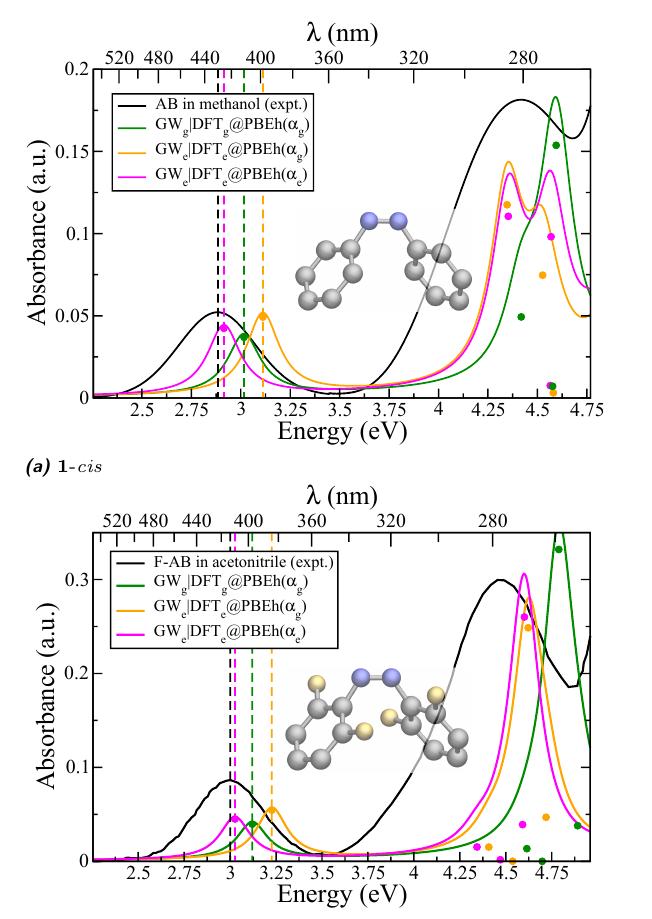
Selected publications:
(Roberta Poloni)

We use, tweak and combine different electronic structure methods in order to adopt the best computational methos for each case. The methods we use are DFT, TDDFT, many-body formalisms such as GW/BSE and multiconfigurational second-order perturbation CASPT2. Classical Monte Carlo simulations are performed in collaboration with Ohio State University. We take pleasure in collaborating with several other computationalists and experimental groups.
Image below: optical spectra of azobenzene and fluorinated azobenzene computed by using GW/BSE and adopting varying embedding schemes coupled with a orbital-tuning approach. An excellent agreement with experiment is found for the fully embedding scheme (see publications in JCTC below).

Selected publications:
- A. R. Kshirsagar, Gabriele D'avino, Xavier Blase, Jing Li, Roberta Poloni Accurate Prediction of the S1 Excitation Energy in Solvated Azobenzene Derivatives via Embedded Orbital-Tuned Bethe-Salpeter Calculations Journal of Chemical Theory and Computation, doi: 10.1021/acs.jctc.9b01257 (2020);
- Chi-Ta Yang, Aseem R. Kshirsagar, Azzam C. Eddin, Li-Chiang Li, Roberta Poloni Tuning gas adsorption by metal-node blocking in photoresponsive metal-organic frameworks, Chem. Eur. J, vol 24, pp. 15167 (2018);
- Y. Lee, Roberta Poloni and Jihan Kim Probing Gas Adsorption in MOFs Using an Efficient Ab Initio Widom Insertion Monte Carlo Method Journal of Computational Chemistry, vol 37, pp. 2808 (2016);



